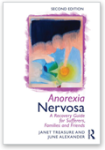The tipping point in recovery from enduring AN – understanding that magical moment
The tipping point in recovery from enduring AN – understanding that magical moment
What is that magical moment that changes in the brain, when someone who has been sick with Anorexia Nervosa for more than 7 years, begins to recover? Why is that person suddenly able to start getting better? How do they make the switch from being captive to their eating disorder thoughts, to being able to focus on recovery? Why can they do this now, and not before? And why can’t others do it too?
What makes it possible, after struggling with AN ‘for years’, to suddenly accept a cream cake or hamburger, and eat it, without feeling anxious?
Or to feel excitement and anticipation, instead of terror and anxiety, when invited to a dinner party, or any social occasion where food is served?
I am among those who have recovered from AN after a long time. Seven years into recovery, I continue to marvel at my ‘escape’ from the AN bully. Stories like mine have inspired researchers, doctors and therapists to wonder if recovery from long term Anorexia Nervosa (AN) really is possible. Is it?
Furthermore, what is recovery?
Professor Stephen Touyz, from The University of Sydney, delved into this minefield of difficult and oft-avoided questions at Australia’s first eating disorder conference for carers and families.
In a nutshell, the good news from Prof. Touyz:
It is never too late to get better!
His definition of recovery:
Recovery is when you totally get over this problem (AN).
You don’t have this illness any more. You are over it. You don’t have it any more.
Something magical
Prof. Touyz shared a video clip of a British woman who developed AN and did not menstruate for 20 years, from age16 to 36.
At 36, something magical occurred in this woman’s brain, and she began to not only menstruate, she began recover and discover her true self. In her mid-forties when the video was taken, the woman was by now in a happy marriage, with a delightful pre-schooler to parent – she had become pregnant at 40. What’s more, she was enjoying a fulfilling career as a journalist.
On reflection, this remarkably insightful woman said her illness had robbed her of ‘an awful lot’ of precious time, and had deprived her of the ability to have close relationships with people. She had often felt alone, and suicidal.
As a child, she had felt pressured. Her parents were ambitious and her father was Victorian in nature. He also was prone to depression.
To recover from AN after 20 years, she agreed, was indeed “an amazing thing”:
“I realise I have missed out a lot of living throughout all these years. (But) these past four years have been the happiest of my life. I have a wonderful relationship with my husband. We travel and go out.”
Re-engaging in society, and developing a degree of maturity, had taken time.
A lot of family support, especially from her mother, had helped the recovery process. “My mother, especially, was so tolerant when I was getting over the illness, and encouraging me to get back into normal life,” the woman said.
What struck me most about this woman was that she harboured no bitterness or resentfulness about the illness that had robbed her of years of her life. Rather, she focused with quite a childlike wonderment and deeply appreciative joy of the here and now.
Hope at all ages

My Kid is Back – Empowering Parents to Beat Anorexia Nervosa – by June Alexander in collaboration with Daniel Le Grange.
Parents of children with AN may shudder at the thought that their child may experience this illness for decades, but the good news is that evidence-based treatments such as Family-Based Treatment are available today. With swift diagnosis and early intervention with FBT, today’s child has a much better chance of getting their life back on track quickly and learning self-care strategies to avoid relapse later on.
Prof. Touyz’s research, importantly, provides hope for sufferers of AN – of every age – who missed an opportunity for early intervention. And believe me, hope is an essential ingredient of recovery. A sufferer needs to ‘believe’ that they will recover. Hearing this from others, helps enormously in re-enforcing this belief. I speak this from the heart, as a sufferer for four decades.
Prof. Touyz referred to his recently-released research,
New Evidence and Approaches in the Psychological Treatment of Severe and enduring Anorexia Nervosa, which backs his optimism for recovery at any age.
What is long standing, chronic or severe and enduring AN?
- There is no generally accepted definition of what constitutes ‘chronicity’ in AN, although seven years of duration is generally accepted.
- It is no surprise that AN is associated with a poor quality of life – with comorbid conditions and social isolation.
- To add to the downsides, sufferers show a tendency to be highly resistant to treatment, tend to be intensive users of GP and health services, and a significant burden to parents, carers and the community.
With this dark picture so drawn, it is really no surprise that AN has the highest mortality rate of all mental illnesses – 20 per cent after 20 years. The picture is not looking good.
Why do patients often refuse treatment?
AN patients often have a strong sense of self-determination which is characterised by perfectionism and rigid inflexibility, associated with marked sense of vulnerability to outsiders’ perceived reality, skills, and value judgments and a strong feeling they should be able to address own difficulties.
“Clinicians try everything but there is no ‘go to’ treatment,” Prof. Touyz said.

A Girl Called Tim – describes my recovery from anorexia and bulimia, and the regaining of my life.
For decades, a string of psychologists and psychiatrists might as well have been talking to the wall behind me, as talking to me – they had no hope of getting through while ‘Ed’ the manipulative eating disorder was dominating my thoughts and behaviours. I would appear say one thing, to indicate receptiveness, but the entrenched AN thoughts would be thinking and plotting another.
People ‘out there’ could not see the illness – they could not see the torment in my brain – all they could see was the mood intolerance, my impaired social and interpersonal skills, my vulnerability to anxiety and depression. I suppose it is no surprise that various people– including family members and clinicians, gave up – labelling me as ‘the problem in the family’, ‘chronic and no hope’, ‘fails to respond’.
Forget the food – focus on improving quality of life
Prof. Touyz has won the respect and become a fan of people with AN everywhere, for refusing to give up on long-term sufferers, for looking outside the square and tackling this difficult area of research with a random controlled trial.
His novel aim was to take people who had been sick for seven or more years, who had received no successful treatment, and to improve their quality of life – to get them out of their apartments and homes and to re-engage in life. Unlike previous treatment efforts, weight loss would be encouraged but not mandated.
The research attitude was:
Let them discover if they like going out (and having fun), and if they do, they will be able to do this more often if they eat more.
A total of 63 medically stable adults took part in the research. Their average age was 32 to 34 and they had been sick for 16-18 years.
Each of these adults had met failure many times before and felt frightened. They needed to be encouraged to have hope and to build relationships.
BACKGROUND:
There are no evidence-based treatments for severe and enduring anorexia nervosa (SE-AN). This study evaluated the relative efficacy of cognitive behavioral therapy (CBT-AN) and specialist supportive clinical management (SSCM) for adults with SE-AN. Method Sixty-three participants with a diagnosis of AN, who had at least a 7-year illness history, were treated in a multi-site randomized controlled trial (RCT). During 30 out-patient visits spread over 8 months, they received either CBT-AN or SSCM, both modified for SE-AN. Participants were assessed at baseline, end of treatment (EOT), and at 6- and 12-month post-treatment follow-ups. The main outcome measures were quality of life, mood disorder symptoms and social adjustment. Weight, eating disorder (ED) psychopathology, motivation for change and health-care burden were secondary outcomes.
RESULTS:
Thirty-one participants were randomized to CBT-AN and 32 to SSCM with a retention rate of 85% achieved at the end of the study. At EOT and follow-up, both groups showed significant improvement. There were no differences between treatment groups at EOT. At the 6-month follow-up, CBT-AN participants had higher scores on the Weissman Social Adjustment Scale (WSAS; p = 0.038) and at 12 months they had lower Eating Disorder Examination (EDE) global scores (p = 0.004) and higher readiness for recovery (p = 0.013) compared to SSCM.
CONCLUSIONS:
Patients with SE-AN can make meaningful improvements with both therapies. Both treatments were acceptable and high retention rates at follow-up were achieved. Between-group differences at follow-up were consistent with the nature of the treatments given.
In both treatments the participants gained weight and improved their quality of life. They experienced less depression, less anxiety. And the good news continued:
At 12 months follow up many of the participants were continuing with the improvements they had made during treatment. Not all continued in treatment but 85 per cent agreed to be follow-up at 12 months which to my knowledge is one of the highest follow-up rates treated patients yet obtained in adult AN.
_ Prof. Touyz
An amazingly heartening and positive result!
Tipping Point
But what about this magical moment, when a person who has suffered AN for years, suddenly starts progressing towards recovery?
To answer, Prof. Touyz referred to the findings of Lisa Dawson, whose research presentation entitled Recovery From Chronic Anorexia Nervosa: The Tipping Point for Change was presented at the Academy of Eating Disorders 2013 ICED in Montreal. Lisa is a PhD student at The University of Sydney and lead author of the paper. Her co-authors, Dr Paul Rhodes and Prof. Touyz, are also her supervisors.
Lisa, in selecting her line of research, had noted:
* A lack of knowledge about recovery from AN.
* Methodological limitations defining ‘recovery’ with previous studies’ revealing a lack of understanding into process over time. And
* No study to date had explored recovery from chronic AN.
Participants were required to have been recovered, ‘to be well’, for five or more years. Chronic AN = more than 7 years.
A total of 86 people were screened, and out of them only 8 met criteria for fully recovered. They were aged from 31 to 64 years, with an illness history of nine to 44 years.
How did the eight people who achieved full recovery, turn this awful illness around after so many years?
Lisa observed that recovery involved four phases:
- Unready/unable to change
- The tipping point of change
- Active pursuit of recovery
- Reflection and rehabilitation
Progression through phases was the same for each participant, but the duration of time in each phase varied. Also, the demarcation of phases was clearly defined for some, while blurred for others.
Phase One – unable to change
- feeling misunderstood
- lack of insight
- internalising the Anorexia Nervosa
- external locus of control
The combination of these factors was associated with low motivation to change. In some cases hopelessness and helplessness was pervasive, shared by patient, clinicians and family alike. Life outside the eating disorder was not highly valued, or able to be highly valued, which seemed to maintain the illness.
Phase Two – tipping point
After years of bingeing and purging I realised the ED wasn’t getting me anywhere. It wasn’t achieving anything. It wasn’t helping me in any way. I couldn’t handle it anymore.
This was the bottom of the well.
I started to feel more understood by those close to me.
The internalised became externalised. Lack of insight turned to insight.
Am I going to let myself die, or beat this thing and make a go of my life? I made a conscious decision to get better. That day was a turning point.
Overtime, perceptions of the AN began to shift. The women appeared to be moving along a continuum from maintaining energy for the AN to starting to feel more worn out by the illness. They were becoming exhausted, defeated and depleted from years spent living with the illness. Some described a sense of ‘hitting rock bottom’. This resulted in the AN becoming de-valued and its worth questioned.
The combination of the severity of the AN and the long-term endurance of the illness led the sufferer altering their original perception of the AN as something of potential value to something that was damaging and unproductive.
When key factors aligned over time, this led to the balance being tipped in favour of pursuing recovery, as opposed to continuing with the illness. Most participants could recall particular moments or turning points.
At this tipping point two key factors emerged:
- an increase in motivation; and
- the establishment of an internal locus of control, that is, the participant now wanted to recover and also felt more able to recover. Most participants recalled making a conscious decision to recover at this stage. All participants began to demonstrate some form of agency over their AN with decisions to change being self-determined and self-initiated rather than being instigated or mediated by others.
Prof. Touyz comments: It doesn’t seem to matter what therapist says.
Phase Three: Active pursuit of recovery
Good days, bad days, but active pursuit of symptom reduction, goal setting.
Phase Four: Reflection and rehabilitation:
Here there is a focus on maintenance, and personal reflection as in ‘learning to love myself’.
A belief that recovery is possible strengthens in combination with support from others.
Lisa Dawson comments:
An important finding revealed in this research is that it is possible to fully (and truly) recover from chronic AN – physically, behaviourally, and psychologically. We set very strict recovery criteria and, at the outset of this research, we did not know if we had ‘set the bar too high’. That is, was it even possible to have had AN for such a long period of time and have normal attitudes to food, shape, and weight? We were looking for a needle in a haystack and we found eight needles. These cases may be the exception in chronic AN, but do illustrate that full recovery is possible.
Conclusion:
- Recovery from chronic Anorexia Nervosa is possible.
- Importance of hope for both patient and clinicians that, while rare, recovery from chronic Anorexia Nervosa is possible.
Further research is required to explore the mechanism of tipping point, and more advocacy work is required to encourage clinicians and researchers on the importance of addressing hopelessness.
For instance, is labelling AN ‘chronic’ a self-fulfilling prophesy?
The eight participants in Lisa’s research had all reached a bottom of the well feeling, a rock bottom feeling that ‘now is the point to do it’.
I relate to this. I was one of the eight participants.
I will continue this focus on recovery. My dream: for long-term sufferers of AN, everywhere, to be able to meet the criteria for fully recovery. If you are suffering, hold on to hope. Don’t give up. Reach out for help today.
If you are a carer – a parent, partner or child – hold on to hope.
If you are a clinician, don’t give up on your patient! Be prepared to look outside the square, as Prof. Stephen Touyz, his colleague Dr Paul Rhodes and their PhD student Lisa Dawson are doing, and seek a way to connect to the true person within.







